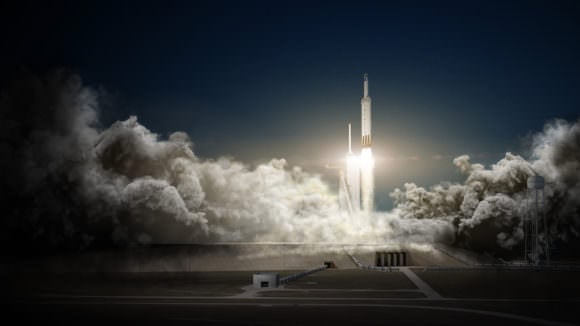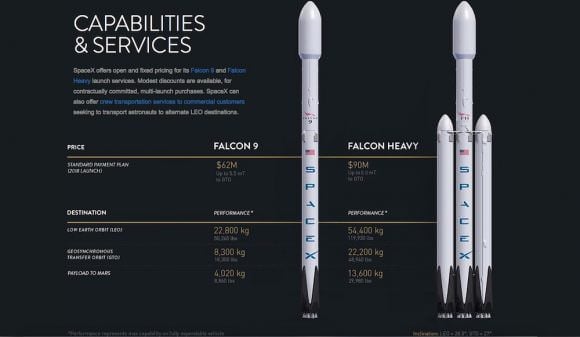Since 2000, Elon Musk been moving forward with his vision of a fleet of reusable rockets, ones that will restore domestic launch capability to the US and drastically reduce the cost of space launches. The largest rocket in this fleet is the
, a variant of the
Falcon 9
that uses the same rocket core, with two additional boosters that derived from the
Falcon 9
first stage. When it lifts off later this year, it will be the most operational powerful rocket in the world.
More than that, SpaceX intends to make all three components of the rocket fully recoverable. This in turn will mean mean that the company is going to need some additional landing pads to recover them all. As such, the company recently announced that it is seeking federal permission to create second and third landing zones for their incoming rockets on Florida's Space Coast.
The announcement came on Monday, July 18th, during a press conference at their facility at the Cape Canaveral Air Force Station. As they were quoted as saying by the
*Orlando Sentinel*
:
[caption id="attachment_128607" align="aligncenter" width="580"]
Artist's concept of the SpaceX Falcon Heavy launching in 2018. Credit: SpaceX[/caption]
At present, SpaceX relies on both drone ships and their landing site at Cape Canaveral to recover rocket boosters after they return to Earth. Which option they have used depended on how high and how far downrange the rockets traveled. But with this latest announcement, they are seeking to recover all three boosters used in a single
Falcon Heavy
launch, which could prove to be essential down the road.
Since December, SpaceX has managed to successfully recover five
Falcon 9
rockets, both at sea and on land. In fact, the announcement of their intentions to expand their landing facilities on Monday came shortly after a spent
Falcon 9
returned to the company's landing site, shortly after deploying over 2268 kg (5000 lbs) of cargo into space during a nighttime launch.
But the planned launch of the
Falcon Heavy
- Falcon Heavy Demo Flight 1, which is scheduled to take place this coming December - is expected to break new ground. For one, it will give the private aerospace company the ability to lift over 54 metric tons (119,000 lbs) into orbit, more the twice the payload of a
Delta IV Heavy
- the highest capacity rocket in service at the moment.
[caption id="attachment_129988" align="aligncenter" width="580"]
Chart comparing SpaceX's Falcon 9 and Falcon Heavy. Credit: SpaceX
[/caption]
Foremost among these are Elon Musk's plans to colonize Mars. These efforts will begin in April or May of 2018 with the launch of the
*Dragon 2*
capsule (known as the "Red Dragon") using a
Falcon Heavy
. As part of an agreement with NASA to gain more information on Mars landings, the Red Dragon will
send a payload to Mars
that has yet to be specified.
Beyond that, the details are a bit sketchy; but Musk has indicated that he is committed to mounting a crewed mission to
Mars by 2024
. And if all goes well with Demo Flight 1, SpaceX expects to follow it up with Falcon Heavy Demo Flight 2 in March of 2017. This launch will see the
Falcon Heavy
being tested as part of the U.S. Air Force's Evolved Expendable Launch Vehicle (EELV) certification process.
The rocket will also be carrying some important payloads, such as The Planetary Society's
LightSail 2
. This 32 square-meter (344 square-foot) craft, which consists of four ultra-thin Mylar sails, will pick up where its predecessor (the
LightSail 1
, which was deployed in June 2015) left off - demonstrating the viability of solar sail spacecraft.
Other payloads will include NASA's
Deep Space Atomic Clock
and
Green Propellant Infusion Mission
(GPIM), the US Air Force's
Innovative Space-based radar Antenna Technology
(ISAT) satellite, the six
Constellation Observing System for Meteorology, Ionosphere and Climate
(COSMIC-2) satellites, and Georgia Tech's
Prox-1 nanosatellite
, which will act as the LightSail 2's parent sattelite.
[caption id="attachment_113302" align="aligncenter" width="580"]
Apollo 11's Saturn V rocket prior to the launch July 16, 1969. Screenshot from the 1970 documentary "Moonwalk One." Credit: NASA/Theo Kamecke/YouTube
[/caption]
The
Falcon Heavy
boasts three
Falcon 9
engine cores, each of which is made up of 9 Merlin rocket engines. Together, these engines generate more than 2.27 million kg (5 million pounds) of thrust at liftoff, which is the equivalent of approximately eighteen 747 aircraft. Its lift capacity is also equivalent to the weight of a fully loaded 737 jetliner, complete with passengers, crew, luggage and fuel.
The
*Saturn V*
rocket - the workhorse of the Apollo Program, and which made its last flight in 1973 - is only American rocket able to deliver more payload into orbit. This is not surprising, seeing as how the
Falcon Heavy
was specifically designed for a new era of space exploration, one that will see humans return to the Moon, go to Mars, and eventually explore the outer Solar System.
Fingers crossed that everything works out and the
Falcon Heavy
proves equal to the enterprise. The year of 2024 is coming fast and many of us are eager to see boots being put to red soil! And be sure to enjoy this animation of the Falcon Heavy in flight:
Further Reading: Orlando Sentinel
 Universe Today
Universe Today



